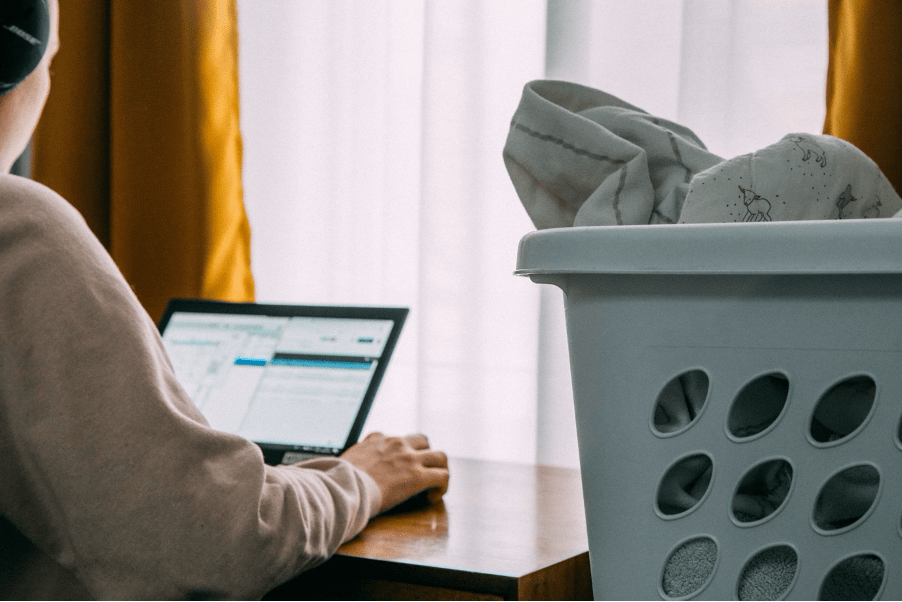86 percent of the U.K. workforce began working from home as a result of COVID-19. That’s 86 percent of people working from their kitchen counters, next to the fridge, with a child at their feet.
With no escape or no return to normalcy in sight – and with the dark and cold winter months fast approaching – things right now are a little trying.
We get it. Everyone here at Yogaline is going through the same motions you are. We have children. We work from home. We’re stuck indoors. Fortunately for us, we also have yoga, and it’s been our lifesaver.
Here’s how a regular yoga practice can help you to de-stress from a tough day working from home and help you maintain a healthy, balanced mindset during this turbulent time in life.
The importance of a home wellness space
We previously published a blog about designing a home wellness space during COVID-19, which you can read here. This is such an important point for us we want to reiterate it in this blog.
See, the key to mental wellness while working from home is routine and compartmentalisation. A shower, getting dressed and eating a healthy breakfast each morning can really set you up for a successful day of work, and having a designated place to work in your home is crucial.
By the same token, a daily yoga practice in a designated ‘calm’ space at home can help you wind down into your evening. Not only is the yoga an important aspect, but performing it in a specific place at a specific time of day is the thing that will keep you mentally well balanced and clear of negative thoughts and emotions.
Yoga and its impact on mental wellness
A regular yoga practice has profound effects on the mind and body. In one study, 34 women diagnosed with an anxiety disorder participated in yoga classes twice weekly for two months. At the end of the study, those who practiced yoga had significantly lower levels of anxiety than the control group.
In another study, 135 seniors were assigned to either six months of yoga, walking or a control group. Practicing yoga significantly improved quality of life, as well as mood and fatigue, compared to the other groups.
Yoga has also been proven to solve many other everyday ailments, including:
- Quality of sleep
- Reducing inflammation in the body
- Improving flexibility and joint strength
- Improving balance
- Reducing migraines
- Reducing chronic pain
- Improving heart health
According to some studies, a daily yoga practice can also improve our cortisol awakening response, which helps not only lower our stress levels, but also improve our resilience to it.
Knowing how positive a yoga practice can be, and how important a specified place in your home to practice is, we want to share with you a few tips on how to design an at-home yoga routine.
Designing an at-home yoga routine
Without your yoga instructor on hand, it can be difficult to design a yoga practice at home and stick to it for any length of time. This is especially the case if you’re burned out and stressed while working from home.
But showing up to the mat each day shouldn’t be a difficult thing, and if you’re prepared enough for it, it won’t be. Here are a few pointers to help encourage you to show up each and every day.
Find the right toolkit
The right yoga mat is an indispensable tool to have on hand. Something comfortable, reliable, non-slippery and made from eco materials is going to encourage you to want to spend time on it every day. By the same token, the right yoga clothing and support blocks will do the same thing.
Much like wearing new clothes that make you feel like you’re worth a million pounds, the right yoga gear will inspire you to practice.
Find the right instructor
Some people enjoy Yoga with Adriene on YouTube. Others like the app Down Dog. Whatever your preference, find something that works for you and stick with it. The right instructor will help you enjoy your practice more. Here’s a short list of places to look to get you started:
- Yoga with Adriene
- Down Dog
- Fightmaster Yoga
- Underbelly Yoga
- Glo yoga
- Daily Yoga
- Boho Beautiful
- Kino Yoga
Turn your tech off
We’ve also mentioned this point in a previous blog, but it stands to reason that we should mention it here, too. Except for your YouTube channel or yoga app, be sure to turn all other technology off. There’s nothing worse than a Slack notification from work halfway through your end-of-practice Shavasana.
Listen to your body
Without an instructor present, it can be difficult to know whether or not you’re practicing yoga safely. To avoid injury, it’s important to listen to your body as best you can and adapt your poses to suit your individual needs.
If you need to use a block, use one. If you can’t spend too long on your wrists, for example, be sure to modify your practice so you can still reap the benefits but without the negative consequences.
Finally, tell your family what you’re up to
This is arguably the most important part of any successful at-home yoga routine. Sure, you love your family, but when it comes to your yoga practice, you need the time and space to find stillness and truly relax.
Hang a ‘do not disturb’ sign on the door, message your husband and tell him not to bother you when he returns with the dog. Send the kids to their rooms. Whatever it takes, the real key to a successful daily yoga practice (and to improving your mental health during COVID-19) is to do something just for yourself, by yourself, each and every day.


Leave a Reply